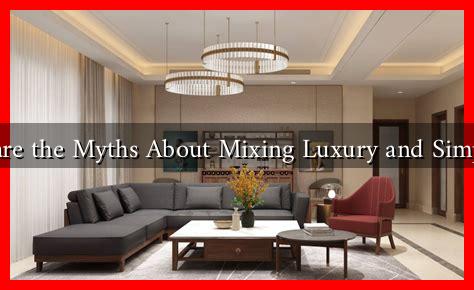-
Table of Contents
- What are the Myths About Mixing Luxury and Simplicity?
- Understanding Luxury and Simplicity
- Myth 1: Luxury is Always Extravagant
- Myth 2: Simplicity Equals Cheapness
- Myth 3: Mixing Luxury and Simplicity is Confusing
- Myth 4: Luxury and Simplicity are Only for the Elite
- Conclusion: Embracing the Harmony of Luxury and Simplicity
What are the Myths About Mixing Luxury and Simplicity?
In a world where consumerism often dictates our choices, the intersection of luxury and simplicity has become a hot topic. Many people believe that luxury and simplicity are mutually exclusive, leading to a plethora of myths surrounding their combination. This article aims to debunk these myths and provide insights into how luxury and simplicity can coexist harmoniously.
Understanding Luxury and Simplicity
Before diving into the myths, it’s essential to define what we mean by luxury and simplicity. Luxury typically refers to high-quality, often expensive goods or services that provide comfort, exclusivity, and status. Simplicity, on the other hand, emphasizes minimalism, functionality, and ease of use. The challenge lies in blending these two seemingly opposing concepts.
Myth 1: Luxury is Always Extravagant
One of the most pervasive myths is that luxury must be extravagant. While many luxury brands showcase opulence, luxury can also be understated and subtle. For instance, brands like Hermès and Chanel often focus on craftsmanship and quality rather than ostentatious displays of wealth.
- Case Study: Hermès – Known for its iconic Birkin bag, Hermès emphasizes quality materials and craftsmanship over flashy designs.
- Example: Minimalist Luxury – Brands like Muji offer high-quality products that embody simplicity without sacrificing luxury.
Myth 2: Simplicity Equals Cheapness
Another common misconception is that simplicity equates to cheapness. In reality, many simple designs are the result of thoughtful engineering and high-quality materials. The minimalist aesthetic often requires a higher level of design expertise to ensure that every element serves a purpose.
- Example: Apple – The tech giant is known for its simple yet elegant product designs, which are often priced at a premium.
- Statistic – According to a study by the Design Management Institute, design-driven companies outperform the S&P by 228% over ten years, highlighting the value of good design.
Myth 3: Mixing Luxury and Simplicity is Confusing
Many believe that combining luxury and simplicity creates a confusing message. However, when done correctly, this blend can create a powerful narrative. The key is to focus on the essence of both concepts and find a balance that resonates with consumers.
- Example: Scandinavian Design – Brands like IKEA and HAY successfully merge luxury and simplicity, offering high-quality products that are both functional and aesthetically pleasing.
- Case Study: Aesop – The skincare brand combines luxurious ingredients with minimalist packaging, creating a cohesive brand identity that appeals to consumers seeking both quality and simplicity.
Myth 4: Luxury and Simplicity are Only for the Elite
Another myth is that luxury and simplicity are only accessible to the wealthy. In reality, many brands are democratizing luxury by offering high-quality products at various price points. This shift allows a broader audience to experience the benefits of both luxury and simplicity.
- Example: Everlane – This clothing brand focuses on transparency and ethical production while offering luxury-quality basics at affordable prices.
- Statistic – A report by Bain & Company indicates that the global personal luxury goods market is expected to reach €1.5 trillion by 2025, showing a growing demand for accessible luxury.
Conclusion: Embracing the Harmony of Luxury and Simplicity
In conclusion, the myths surrounding the mixing of luxury and simplicity often stem from outdated perceptions and a lack of understanding. Luxury does not have to be extravagant, and simplicity does not equate to cheapness. By embracing the harmony of these two concepts, brands can create compelling narratives that resonate with consumers across various demographics.
As we move forward, it’s essential to challenge these myths and recognize that luxury and simplicity can coexist beautifully. Whether through thoughtful design, quality materials, or accessible pricing, the blend of luxury and simplicity offers a unique opportunity for brands to connect with consumers on a deeper level.
For more insights on luxury and design, consider exploring resources like Design Management Institute.

